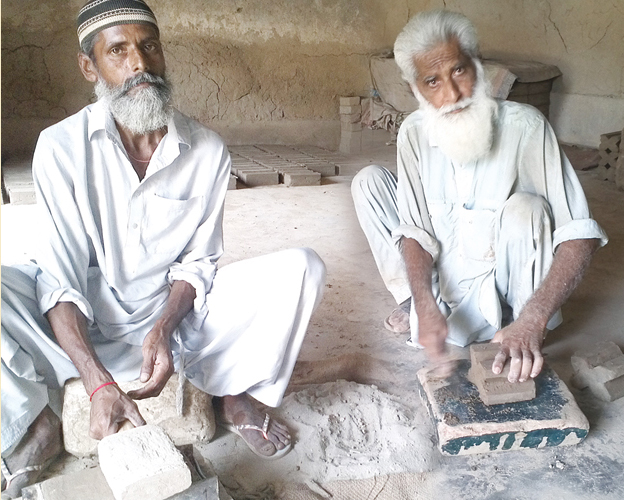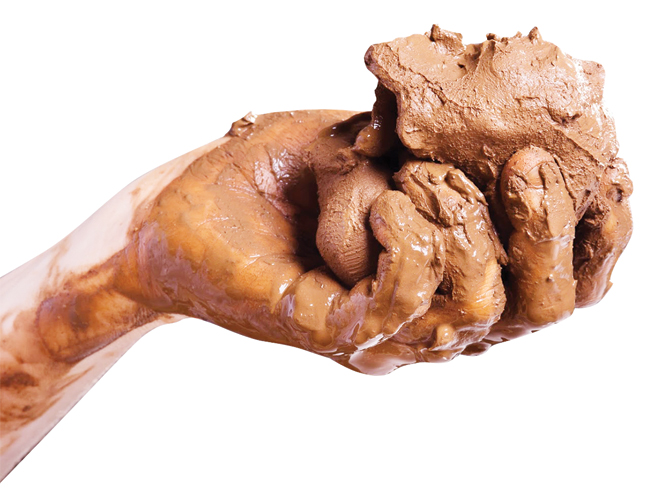CULTURE
Hafiz Muhammad Siddiq, 62 years old, is one of the few old artisans from Nasarpur Town, Matiari district, who makes traditional ceramics and kasha-kari tiles. It is one of the oldest professions, and very few of the artisans want to continue, as the returns are not as high as they used to be.
 Nasarpur town has been a major hub of handmade items, ranging from clothes to kashi (masonry), ceramics, carpet work, shawls, pottery, milk products, and sweets, etc. It is also famous for producing specific varieties of onion and mangoes.
Nasarpur town has been a major hub of handmade items, ranging from clothes to kashi (masonry), ceramics, carpet work, shawls, pottery, milk products, and sweets, etc. It is also famous for producing specific varieties of onion and mangoes.
In ancient times, it was considered a gateway for trade, and supplied local products throughout the regional markets. Historians write about this city as a major artery between Sindh and Delhi, India to supply goods to buyers in old times. The trade route thrived for a considerable time, but now barely survives the onslaught of modernism and globalisation.
Now, only four small factories survive as masonry and ceramics seem to have lost their mass attractive for the public. For people like Siddiq, the few patrons who still appreciate this art are a blessing; otherwise even the four working manufacturing ceramic units will shut down. Centuries old small factories, manufacturing traditional artwork, have been shut, also closing down avenues to earn a living for the people living in the town and its surrounding areas.
This ancient city was the centre of the artworks long ago. Old famous artisan towns like Hala, Matiari, Tando Muhammad Khan, etc, fed their crafts to the city for trade. The markets were flooded with handicrafts and other items, which were also sent abroad due to their high cultural value.
The link via the Indus River in those times also played a major role in transporting goods and manufacturing clay artefacts. The river changed its course, and is now flowing at a considerable distance. However, it does not deter people like Siddiq to take the malleable clay from the riverbed that is essential for the ceramics. The old citizens still link the ceramic and masonry artwork to the old river bed and take useful clay for their work.
The apprentice
Siddiq claims to have started this work at the age of 12 as an apprentice and till date he comes daily, guides beginners and works the whole day.
"I saw my father do the same. He was a strong man and an expert in this field. He died at the age of 102 years while he was at this same workplace. I do not like to stay idle at home, because I want to live healthy and rely on my own wages," he said while emphasising the importance of staying active and remaining independent despite old age. “All it takes is willpower,” he said.
Looking back
Nasarpur city, being an old and attractive business centre was also the gateway of rulers which was ruined during invasions and later rebuilt several times in the past. The sixth Mughal emperor, Auarangzeb Alamgir (1618-1707), also contributed to the rebuilding of this city to restore its glorious status.
Recalling the past, Siddiq said the city had a magnificent status up till the early sixties, when all the handicrafts and artwork attracted buyers and traders from other areas. It was a time when business was extremely good and the town was prosperous. “Businesses reached a peak in those days,” he said. That was also the time when hundreds of factories provided a stable source of living to the artisans and local workers, he said.
 Kashir-kari is a dying art form. In Persian it literally means mosaic art. The main workshops of kashi are in Lahore, Multan, Thatta, Hala Nasarpur, Mahra Sharif, and Dera Ismail Khan, and they are on a decline everywhere. “Now we rely on a few people who buy these products to decorate their homes, or the mosques and shrines,” he said.
Kashir-kari is a dying art form. In Persian it literally means mosaic art. The main workshops of kashi are in Lahore, Multan, Thatta, Hala Nasarpur, Mahra Sharif, and Dera Ismail Khan, and they are on a decline everywhere. “Now we rely on a few people who buy these products to decorate their homes, or the mosques and shrines,” he said.
To assemble
Khamiso Khaskheli, another senior artisan, said the colourful Sindhi kashi and ceramic tiles and masonry are used as building materials. “They are specially used in building shrines and mosques to add value and beauty,” he said.
Even now, many of the artisans in Matiari district are employed by shrines and mosques for renovation work. They travel all over the province to repair the broken kashi tiles and re-embellish the masonry products.
Khamiso himself has spent more than 45 years at the factory and continues to remain associated to the workshop. Though his children and grandchildren have switched from their traditional profession and after education joined various fields, Khamiso still prefers his daily visits to the workshop. It is not just his bread and butter, but also a place where he works and feels at peace.
Money matters
The amount being paid to these workers does not match even the government's fixed minimum wages criteria, but these senior artisans seem happy to continue work instead of staying idle at homes.
Aslam Channa, who works as an artisan at the ceramic centre, identified the issues related to the decline in this ancient industry of Sindh. He blamed the lacklustre attitude of the government towards this traditional artwork as one of the major reasons for the decline in this industry.
Since he is also associated with the Mehran University of Engineering and Technology (MUET) Centre of Excellence as an assistant for guiding students about sculpture and other related designs, he said that not just kashikari, but the overall ceramic industry faced many problems due to the lack of government interest. “There is no government interest to save this traditional sector,” he said.
He suggested the government to improve and develop the necessary infrastructure to ease the access to e-commerce and tourists. “This will ultimately ensure long term prosperity of small scale artisan businesses and also simultaneously improve their quality of life,” Channa said.
He believes that lack of physical infrastructure in rural areas, unavailability of raw material, scarcity of water, and electricity issues have made it difficult for the artisans to continue their work.
He said local artisans had learned this skill from their elders. Therefore, presently provision of technical advice and further training is limited. So the new emerging workers need training and linking it to an innovative ceramic industry to save this craft and work.
The artisans lament the lack of their buying power and also the land mafia headed by the local landlords who use the river bed for agricultural purposes. Access to firewood is also a problem, they pointed out. “It costs Rs250-Rs300 per maund (37.32 kilograms), depending on the availability of wood in the area,” they said. Matching colours for shining products are cost the highest compared to even the cost of labour, they explain. These issues combined contribute to the rapid decline in this old industry.
Only a few families are now running the remaining old traditional ceramic factories in the city. Otherwise, the workshops for other handicrafts and products have been shut down due to various reasons, including the lack of demand for the wares and crafts.
Showing wares
The workers proudly showed off their work which they completed by applying various processes. The factory had separate kilns to bake each product. The artisans still rely on the traditional method of burning firewood to bake their wares.
They burn at least 1.4-1.7 tonnes of firewood to bake the different products for 14-16 hours. After the appropriate temperature has been applied to the clay work, the items are left to cool down for two days. After that, another two days are required to prepare and make the wares ready for the market.
Mechanical advancement
Artisans also point out that the machine work was replacing handmade ceramic and kashi tiles. “Handcraft takes time, and people do not like to wait for a long time now after placing their order, so they prefer buying the machine made products instead of the handmade ones,” the artisans said. There are plenty of readymade ceramics and tile works available in the markets now, and the craftsmen rely on very few buyers and connoisseurs.
These choice buyers visit the factories to place orders for building their houses, decorating walls and roofs using the colourful kashikari tiles and geometric bricks.
Caretakers of shrines and mosques also come for this product. This is the only reason that the people continue running these factories to keep the old artwork alive.

Reviving tradition
Nasarpur was one of the oldest city-settlements in the Indus Valley Civilisation, which thrived in ancient times along the Indus River.
Senior artisans, talking about the Indus Civilisation, said, “Sadly, the region, known as the cradle of civilisations is now only preserved in history books. Practically, it is all has gone now, leaving almost no witness for the new generations.”
The artisans highlighted the issues and suggested practical strategies for the revitalisation of traditional crafts, which were created by their elders who resided in this city for generations. “The government needs to take an interest in art and craft to revive this industry which can provide employment to hundreds,” they said, while demanding the government to upgrade infrastructure and support systems for the community of artisans and craftsmen.
The writer is a staff member